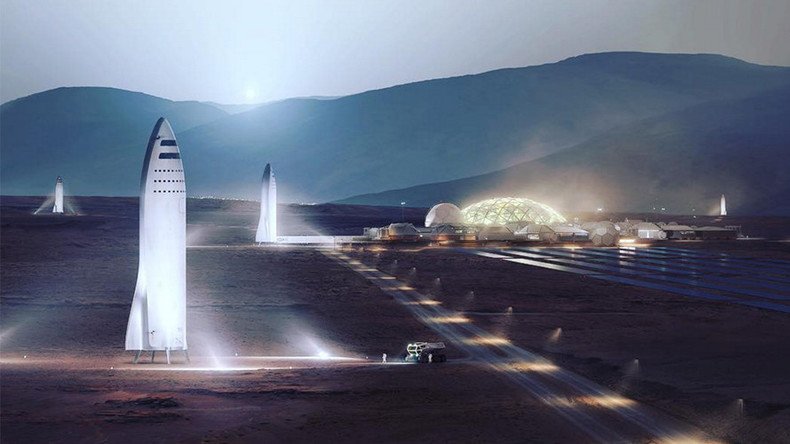Musk’s ‘Big F*cking Rocket’ will get you ‘anywhere on Earth in under an hour’ (VIDEOS, PHOTOS)

Everyone's favorite comic book supervillain, Elon Musk, has unveiled his latest set of dastardly plans. The South African-Canadian billionaire wants to make humans a multi-planetary species, and his patience has just about run out.
Musk revealed his latest ambitious plans at the International Astronautical Congress in Adelaide, Australia, on Friday. He and his company, SpaceX, already have an impressive CV, but these latest plans, if achieved, will revolutionise human space travel.
The company’s aptly-titled “Big F*cking Rocket (BFR)” will be crucial to the plans, which looks set to be used for much more than just trips to the moon and Mars.
A derivative of SpaceX’s Falcon rockets, which have successfully taken supplies to the International Space Station and returned safely to Earth, Musk plans to use the BFR for terrestrial trips too.
The aim, he claims, is to bring passengers “anywhere on Earth in under an hour,” essentially making any city accessible to the weekend traveler.
For example, if you wanted to go from New York to Shanghai, you’d take a ferry from an NYC dock to a massive floating launchpad just off the coast. The BFR would then blast off, taking you into orbit. A mere 39 minutes - and 7,000 miles (11,265km) - later you touch down on a similar pad just off the coast of Shanghai. Simple.
“Cost per seat should be about the same as full fare economy in an aircraft,” Musk said on Instagram. “Forgot to mention that.”
He’s not done there, however, with the BFR’s real purpose being to get humans to Mars, which in turn involves stopping off at the SpaceX moon base.
“We can land the ship [BFR] on the moon and return without need for propellant production on the moon,” Musk said. “It’s 2017, we should have a lunar base by now. What the hell’s going on?”
“The future is vastly more exciting and interesting if we’re a space-faring species than if we’re not,” Musk said, as he began outlining his vision for Mars. “It’s about believing in the future and thinking the future will be better than the past.”
To that end, the first BFR is set to begin construction within six to nine months. The aim is to land at least two cargo missions on the red planet by 2022, with human settlers following just two years later in 2024.
Those first colonisers will be charged with establishing a permanent base that Musk hopes will one day grow into a thriving city of 1 million Martians.
Supporting the creation of a permanent, self-sustaining human presence on Mars. https://t.co/kCtBLPbSg8pic.twitter.com/ra6hKsrOcG
— SpaceX (@SpaceX) September 29, 2017
This all sounds fantastical, but how are Musk and SpaceX going to fund these endeavors? As ever, the inventor has a plan to ‘cannibalise’ SpaceX’s entire fleet of spacecraft - the Falcon 9, the Falcon Heavy, and the Dragon spacecraft - rendering them obsolete.
“We can build a system that cannibalizes our own products, makes our own products redundant, then all the resources we use for Falcon Heavy and Dragon can be applied to one system,” he said.
“All our resources will turn toward building BFR. And we believe we can do this with the revenue we receive from launching satellites and servicing the space station.”
But will it work? Musk has reason to be optimistic, noting that the Falcon 9 rocket has pretty much been perfected.
“That’s what they’ve been doing across 16 successful landings in a row,” he said. “And that’s really without any redundancy. The Falcon 9 lands on a single engine and when you have high reliability with single engine, then you can land with either of two engines [which the BFR will have], and you probably can achieve landing reliability on par with most commercial airlines.”
Musk’s full speech can be viewed below.












